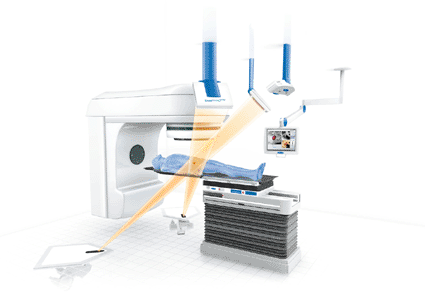Stereostactic Image-Guided Radiotherapy Benefits High-Risk Patients
By MedImaging staff writers
Posted on 07 Jan 2008
Posted on 07 Jan 2008

Image: The ExacTrac X-Ray 6D System for image-guided radiotherapy (Photo courtesy of BrainLAB).
Most of the patients treated with this technology at the Stony Brook University Medical Center (Stony Brook, NY, USA) have experienced few or no side effects when treated for lung cancer or other forms of disease with this radiotherapy system. The power and precision of the system also allows for short therapeutic duration. Treatments take one-to-two weeks to complete and require only three or four doses. Conventional beam therapy frequently lasts many weeks and many doses. BrainLAB (Feldkirchen, Germany) is the developer of the ExacTrac system.
"We have had substantial success in treating patients with tumors of the lung, brain, spine, head and neck, and prostate with the ExacTrac system,” stated Allen G. Meek, M.D., chair of the department of radiation oncology, indicating that the system has become an integral part of the department's therapeutic options after several months in operation. "ExacTrac enables us to deliver treatment to some previously irradiated sites without damaging critical structures like the spinal cord,” explained Dr. Meek. "This greatly improves our ability to treat some inoperable tumors and cancers that spread from primary sites.”
"Scarring is considerably reduced with this new modality because it delivers top-of-the-line aiming capability using low-dose beams from many directions that converge on the same target to deliver a high dose,” said Thomas Bilfinger, M.D., professor of surgery and co-director of the Lung Cancer Evaluation Center at Stoney Brook. "Less scarring leads to fewer losses of functioning tissue over time, which can be particularly beneficial for lung cancer patients.”
The treatment procedure with the ExacTrac System consists of four key steps: (1) An automated and image-guided patient positioning system, based on the patient's form and location of tumor, is used for the initial patient set-up; (2) high-resolution X-rays pinpoint internal tumor sites, verifying the location across six dimensions and calculating key reference points for delivery of radiotherapy; (3) a remote control system corrects any initial patient set-up errors; and (4) the system tracks any patient movement that may affect treatment during the entire session.
"The imaging component is critical to the process,” added Bong S. Kim, M.D., assistant professor of clinical radiation oncology. "We can position the patient within two millimeters precision, which maximizes radiation treatment directly to the tumor.”
For SBRT to be effective, optimal patient immobilization is required. The ExacTrac system uses the most sophisticated technology available for ensuring that the patient is positioned for treatment as accurately as possible. The computerized BodyFix system guides the overall system by way of a non-invasive vacuum activated immobilization and fixation unit. This device limits movement caused by patient breathing, as well as tumor movement.
Related Links:
Stony Brook University Medical Center
BrainLAB













